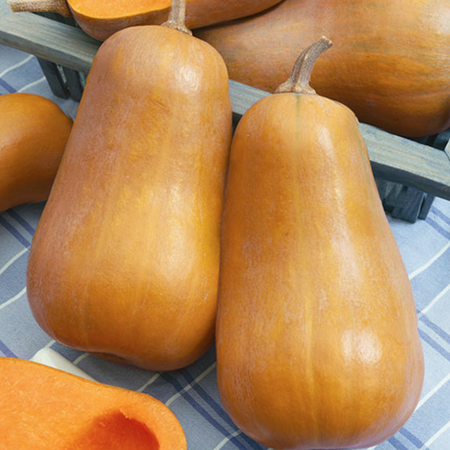Honeybaby, (F1) Squash Seeds
Key Attributes
Key Attributes
Product Details
Weight
.01Plant Height
12-18"Botanical Name
Cucurbita moschataSeed Type
SeedAdditional Characteristics
All American SelectionSeeds Per Gram
9Seeds Per Pound
4,200Row Spacing
3'Packet
20 SeedsSow Depth
1"Disease Resistance
DM, PMSeeds Per Ounce
260Breed
F1 HybridSun
Full SunTypes
ButternutMaturity
Main SeasonCubic Inches
2.925Life Cycle
AnnualSow Method
Direct SowPlant Spacing
24"Categories
SquashGermination
4,5,6,7,8,9Days To Maturity (# Days)
90Seeds Per Acre
3.6 lbsComponents
Growing Instructions
![]() Learning Download: How to Grow Squash
Learning Download: How to Grow Squash
Squash is a very versatile plant to grow, with many different options for the home garden.
Squash is an easy plant with high yields and comes in many different varietals. Winter squashes such as acorn, delicata and butternut can be used in dishes or even for decoration as a centerpiece of a table.
Before Planting: Squash prefers fertile, well-drained soil with a pH of 6-7.0. Plastic mulch and fabric row covers (AG-19 grade) can aide plant establishment and exclude insect pests during the seedling stage.
Planting: Squash grow well in mounds, so hill up some soil and plant three to five seeds per mound. Plant seeds 1 inch deep in mounds set 4 feet apart after all danger of frost has passed. Squash can be started indoors three to four weeks before the last frost date. Squash also grow well in pots or buckets, 5 to 10 gallons is large enough. Row covers should be removed when plants begin to flower.
Watering: Water at least 1 inch a week. Mulching can also help retain moisture.
Fertilizer: To encourage squash growth, it is important to fertilize prior to planting the seeds and during its growing
season as well. Prior to planting seeds, mix up to 3 inches of compost into the soil where you plan to plant the seeds. Instead of composting, you can use a 5-10-10 fertilizer and spread 1 tablespoon per mound prior to planting. Throughout the squash’s growing season, use the 5-10-10 fertilizer monthly.
Days to Maturity: Summer squash varieties like zucchini and yellow squash can be harvested when they are young and tender or you can wait until they reach their full size, which is generally 6 to 8 inches long. (See each variety for days to maturity)
Harvesting: Harvest regularly, 2-3 times a week, once plants begin to produce. Zucchini will have a healthy
sheen to its green skin. Winter squash like acorn, delicata or butternut squashes are ready to harvest when their outer rind resists puncture by a fingernail. Cut or gently twist off fruits when they have reached the desired size. For summer squash, 4-6″. Keep fruit at 40-50°F with 95% relative humidity.
Tips: Squash blossoms are also edible. Pick the first blooms that appear, as those are the males and if picked, they will not affect plant yields later in the season. Remove the interior of the blossom and add the petals to salads.
AVG. Seeding Rate: 3 seeds/ft., rows 6′ apart, 250 seeds/83′, 500 seeds/166′, 1,000 seeds/333′.
Shipping Schedule
Our Seed Promise
 "Agriculture and seeds" provide the basis upon which our lives depend. We must protect this foundation as a safe and genetically stable source for future generations. For the benefit of all farmers, gardeners and consumers who want an alternative, we pledge that we do not knowingly buy or sell genetically engineered seeds or plants.
"Agriculture and seeds" provide the basis upon which our lives depend. We must protect this foundation as a safe and genetically stable source for future generations. For the benefit of all farmers, gardeners and consumers who want an alternative, we pledge that we do not knowingly buy or sell genetically engineered seeds or plants.
The mechanical transfer of genetic material outside of natural reproductive methods and between genera, families or kingdoms, poses great biological risks as well as economic, political, and cultural threats. We feel that genetically engineered varieties have been insufficiently tested prior to public release. More research and testing is necessary to further assess the potential risks of genetically engineered seeds. Further, we wish to support agricultural progress that leads to healthier soils, to genetically diverse agricultural ecosystems, and ultimately to healthy people and communities.
To learn more about the "Safe Seed Pledge" please visit www.councilforresponsiblegenetics.org.

